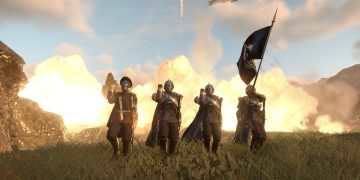Creating the visuals and setting for your game is one thing, but crafting the gameplay and narrative that form its backbone is quite another. How did you approach this challenge? Fukushima: We were fortunate that Acquire pitched a compelling initial concept for our core gameplay. Essentially, their proposal described it as “a Mario story that’s uniquely yours, with adventures on drifting islands.” That caught our attention, and we asked them to start prototyping.
Ohashi: The idea of drifting islands was intriguing to me. Imagine discovering an island, embarking on adventures, and forming friendships with its inhabitants. The concept of connecting multiple islands and gathering allies for your journey sounded incredibly engaging.
Otani: I must admit, it was a remarkable idea. During our brainstorming sessions at Nintendo, we hadn’t considered anything like it. The idea of linking multiple islands as part of the gameplay was a novel concept. (Laughs)
Ohashi: However, we struggled for quite some time to capture the “Mario & Luigi-like” essence we were aiming for, so testing for this new feature took a back seat. Our discussions on how to make this island gameplay enjoyable lasted longer than expected, causing delays in presenting concrete ideas to Nintendo, which understandably concerned them.
Otani: I admit, I started to feel uneasy. Fukushima-san and I were keen on seeing Acquire’s ideas and were wondering when they would be ready. (Laughs)
Fukushima: We had faith in Ohashi-san’s thorough approach, as he’s someone who prefers to deliver a decisive answer only when he’s completely satisfied. But that didn’t stop us from holding numerous internal strategy meetings to figure out how long we could afford to wait. (Laughs)
Ohashi: In our game, Shipshape Island is Mario and his friends’ strategic base, drifting through the ocean toward new adventures on various islands. Developing systems to facilitate the island’s movement across the vast sea was challenging and time-consuming.
Fukushima: Normally, the gameplay and narrative direction are sorted early in development, with details filled in thereafter. But this took more time than we anticipated. During development, such as refining the island’s movement or deciding on the scale like the number and themes of islands, it sometimes felt like chasing rainbows. It was demanding work.
Otani: Complication arose due to the differing development styles between our companies. Our traditional approach involved crafting gameplay first, followed by a plot that complemented it, with the director steering progress. However, Acquire’s method had Ohashi-san focusing on island gameplay separately while an external company worked on the story, in parallel. For an RPG, though, both the story and gameplay need harmony to progress effectively.
Ohashi: Our story collaborators initially struggled to nail that “Mario & Luigi-like” vibe, and finding a suitable storyline proved difficult.
But eventually, you found a solution, didn’t you?
Ohashi: Yes, I recall when we progressed. We decided together on plot themes for each sea – like “family” for the first sea, “friends” for the next, and so forth.
Fukushima: Exactly, that’s when the pieces began to align through the overarching theme of “connection”. While gameplay involved linking islands, the narrative revolved around the connections among the island inhabitants as well.












![[Free Game Offer] Pets Hotel Giveaway (PlayStation – NA or EU) [Free Game Offer] Pets Hotel Giveaway (PlayStation – NA or EU)](https://www.gamera.co.uk/wp-content/uploads/2025/05/Free-Game-Offer-Pets-Hotel-Giveaway-PlayStation-–-NA-or-360x180.jpg)


































